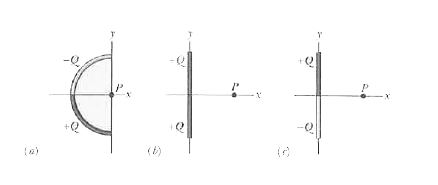L shaped rod has equal and opposite charge (+- Q) spread along its both arms (see figure). (a) What is direction of electric field at point P? (b) Write electric potential at P.

The correct Answer is:(a). Prallel to −−→AB
(b). Zero
Step by step video, text & image solution for L shaped rod has equal and opposite charge (+- Q) spread along its both arms (see figure). (a) What is direction of electric field at point P? (b) Write electric potential at P. by Physics experts to help you in doubts & scoring excellent marks in Class 12 exams.
Updated on:21/07/2023Topper's Solved these Questions
- ELECTROSTATICSBook:ARIHANTChapter:ELECTROSTATICSExercise:Level 3
Explore 59 Videos
- ELECTROSTATICSBook:ARIHANTChapter:ELECTROSTATICSExercise:Level 3
Explore 59 Videos
- ELECTROMAGNETIC INDUCTIONBook:ARIHANTChapter:ELECTROMAGNETIC INDUCTIONExercise:Level 3
Explore 12 Videos
- GEOMETRICAL OPTICSBook:ARIHANTChapter:GEOMETRICAL OPTICSExercise:Level 3
Explore 9 Videos
Similar Questions
Knowledge Check
An electric dipole is the combination of two equal and opposite charges q and -q, respectively, separated by distance 2a. There are different points where we can find electric field due to the electric dipole. In the given table, column 1 shows different positions of point where we have to find electric field due to dipole, column 2 shows the figure of dipole with different positions of point where we have to find the electric field and column 3 shows the value or final formula of the electric field of different positions of the point.
When point P lies on the equatorial plan of the electric dipole, electric field due to -q is ?

 A(I) (i) (J)B(I) (i) (M)C(III)(iii) (J)D(I) (i) (K)
A(I) (i) (J)B(I) (i) (M)C(III)(iii) (J)D(I) (i) (K)An electric dipole is the combination of two equal and opposite charges q and -q, respectively, separated by distance 2a. There are different points where we can find electric field due to the electric dipole. In the given table, column 1 shows different positions of point where we have to find electric field due to dipole, column 2 shows the figure of dipole with different positions of point where we have to find the electric field and column 3 shows the value or final formula of the electric field of different positions of the point.
when point P lies on the equatorial plane of the electric dipole, electric field due to +q is ?

 A(III) (ii) (L)B(IV) (i) (M)C(III) (iii) (J)D(I) (i) (M)
A(III) (ii) (L)B(IV) (i) (M)C(III) (iii) (J)D(I) (i) (M)An electric dipole is the combination of two equal and opposite charges q and -q, respectively, separated by distance 2a. There are different points where we can find electric field due to the electric dipole. In the given table, column 1 shows different positions of point where we have to find electric field due to dipole, column 2 shows the figure of dipole with different positions of point where we have to find the electric field and column 3 shows the value or final formula of the electric field of different positions of the point.
When point P lies on the axis of the electric dipole, electric field due to -q is ?

 A(III) (ii) (L)B(II) (iii) (L)C(II) (iii) (J)D(I) (i) (K)
A(III) (ii) (L)B(II) (iii) (L)C(II) (iii) (J)D(I) (i) (K)
Find the direction of electric field at P for the charge distribution as shown infigure.

View SolutionConsider a uniformly charged hemispherical shell. What can you say about the direction of electric field at points on the equatorial plane. (e.g. point P)

View Solutionv37
View SolutionOn the basis of your understanding of the following paragraph and the related studied concepts.
An equipotential surface is a surface with a constant value of electric potential at all points on the surface. The component of electric field parallel to an equipotential surface is zero, as the potential does not change in this direction. Thus, the electric field is perpendicular to the equipotential surface at each point of the surface. Further, say the direction of electric field electrical potential gradually fall with distance.
Draw equipotential surfaces around an isolated positive point charge + q. Mark direction of electric field →E also.
View SolutionThe figure here shows three nonconducting rods, one circular and two straight. Each has a uniform charge of magnitude Q along its top half and another along its bottom half. For each rod, what is the direction of the net electric field at point P ?

View Solution


